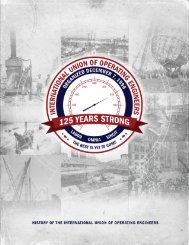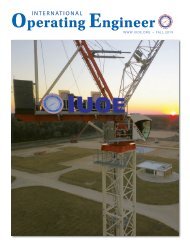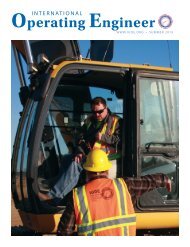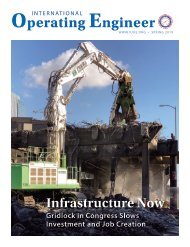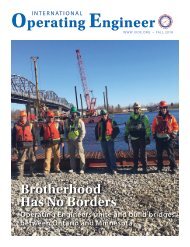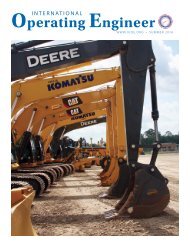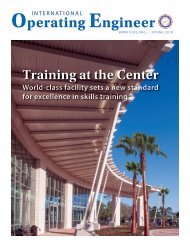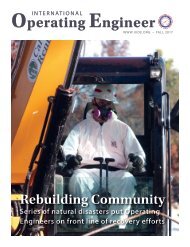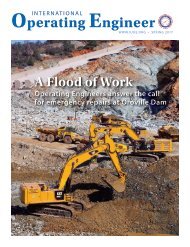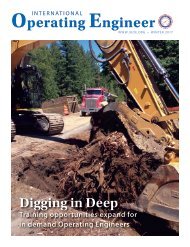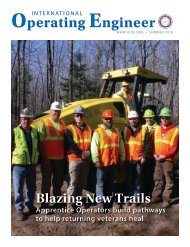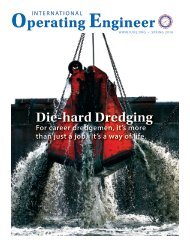Operating Engineer - Spring 2014
The quarterly magazine of the International Union of Operating Engineers.
The quarterly magazine of the International Union of Operating Engineers.
Create successful ePaper yourself
Turn your PDF publications into a flip-book with our unique Google optimized e-Paper software.
Politics & Legislation<br />
Transportation Bill Progresses, but Solution Still Miles Away<br />
SENATOR BARBARA BOXER<br />
(D-CA), Chairman of the Senate<br />
Environment and Public Works<br />
Committee, again took a leadership<br />
role in support of the nation’s<br />
transportation system as she navigated<br />
a full six-year highway and transit law<br />
through her committee in May. Both<br />
Republicans and Democrats came<br />
together to support the bipartisan<br />
legislation, which builds on past policy<br />
progress made in MAP-21, the twentyseven<br />
month legislation that expires at<br />
the end of September. The committee<br />
bill includes a bipartisan emphasis on<br />
delivering projects more efficiently<br />
and quickly; focusing the precious<br />
transportation resources where they<br />
are needed most; creating a new freight<br />
program; and investing in a new grant<br />
program to reward cities and states for<br />
project innovation.<br />
In a statement, Sen. Boxer said: “This<br />
job-creating legislation will provide<br />
the long-term certainty that states,<br />
cities, and businesses need…” General<br />
President Callahan agreed, saying,<br />
“Senator Boxer has been a tenacious<br />
fighter for transportation investments.<br />
We appreciate her willingness to reach<br />
across the aisle to develop commonsense<br />
solutions for America’s failing<br />
public infrastructure.”<br />
The legislation still has a long way to<br />
go to become law. Three other Senate<br />
committees must still take action.<br />
Lawmakers must also reach a deal<br />
to raise billions in revenue to resolve<br />
the funding shortfall in the Highway<br />
Trust Fund. The Highway Trust Fund is<br />
primarily funded by deposits from the<br />
gas and diesel taxes. It is projected to<br />
have an annual shortfall in October of<br />
roughly $15 billion a year. Inflation and<br />
increased fuel-efficiency have taken<br />
a toll on revenues. Lawmakers will<br />
need to find $15 billion for every year<br />
the transportation law lasts. While the<br />
gas and diesel tax is by far the largest<br />
revenue source for the Highway Trust<br />
Fund, politicians in Washington have<br />
been unwilling to raise the tax by 15<br />
cents, which would be necessary to fill<br />
the hole.<br />
The current law, MAP-21 (Moving<br />
Ahead for Progress in the 21st<br />
Century), is set to expire on October 1<br />
at the start of the new fiscal year. But<br />
the crisis in the Highway Trust Fund<br />
will hit even before the old law expires.<br />
The Highway Trust Fund is insulated<br />
from other parts of the budget. The<br />
Highway Trust Fund delivers the<br />
federal government’s transportation<br />
funding obligations to states and local<br />
governments. It is scheduled to run<br />
out of money sometime in late July or<br />
early August. Without a solution — at<br />
least a short-term patch of money —<br />
the shortfall could wreak havoc with<br />
State Departments of Transportation<br />
and the whole national transportation<br />
system.<br />
The nation’s transportation<br />
program operates on a system<br />
of reimbursements. As the states<br />
look to the federal government for<br />
reimbursements for money that they<br />
had already given to construction<br />
contractors on federally-approved<br />
projects, the U.S. Department of<br />
Rep. Bill Shuster (R-PA)<br />
Transportation may have no choice<br />
but to temporarily withhold payment,<br />
slowing payments to states, contractors,<br />
and, potentially, to workers.<br />
General President Callahan called<br />
on Congress to waste no time in<br />
building on the Senate committee’s<br />
progress and passing key job-creating<br />
legislation for <strong>Operating</strong> <strong>Engineer</strong>s.<br />
“This bill employs thousands of us. We<br />
need Congress to do its job, so we can<br />
do ours.”<br />
U.S. Department of Transportation<br />
Secretary Anthony Foxx, has sent<br />
the Administration’s transportation<br />
proposal, the Grow America Act, to<br />
Senator Landrieu Introduces Bill to Build Keystone XL Pipeline<br />
U.S. SENATORS MARY LANDRIEU<br />
(D-LA), the chair of the Senate Energy<br />
and Natural Resources Committee,<br />
and John Hoeven (R-ND), have<br />
introduced legislation that would<br />
immediately authorize TransCanada’s<br />
application with the State Department<br />
to build the Keystone XL pipeline. The<br />
binding bi-partisan bill is cosponsored<br />
by eleven Senate Democrats<br />
and all the Senate Republicans.<br />
On April 18, <strong>2014</strong> the State<br />
Department ruled that they would not<br />
make a decision on the Keystone XL<br />
pipeline until the on-going litigation<br />
in the Nebraska Supreme Court,<br />
surrounding the project, has concluded.<br />
They also stated they wanted to give<br />
federal agencies more time to submit<br />
comments regarding the project. This<br />
means that the State Department will<br />
not make a decision on the project<br />
until the end of the year or early 2015.<br />
On the decision, IUOE General<br />
President Callahan made the following<br />
statement, “After five different<br />
Environmental Impact Statements<br />
and over five years of evaluation, the<br />
Keystone XL pipeline has been the<br />
most exhaustively reviewed pipeline in<br />
history. All of the federal studies have<br />
reached the same conclusion: The<br />
Keystone XL pipeline merits approval.”<br />
Capitol Hill. The legislation would<br />
invest more annually ($302 billion<br />
or roughly $75 billion a year) than<br />
the bipartisan Senate bill. Yet those<br />
investments would be paid for by<br />
reforming the corporate tax structure<br />
– something that most Capitol Hill<br />
watchers believe is not possible. The<br />
legislation would last for four years,<br />
encourage local hiring, and create a<br />
new focus on American rail, including<br />
both freight and passenger rail.<br />
Senator Landrieu understands<br />
the importance of this project and<br />
what it means for the livelihood of<br />
thousands of IUOE members and<br />
Senator Mary Landrieu (D-LA)<br />
other construction workers. The<br />
Keystone XL pipeline will move an<br />
essential North American commodity<br />
more safely than other alternatives.<br />
In addition, the pipeline will improve<br />
public safety, enhance American<br />
The House of Representatives<br />
is expected to consider its own<br />
transportation legislation soon.<br />
Chairman Bill Shuster (R-PA), House<br />
Transportation and Infrastructure<br />
Committee, has committed to moving<br />
bipartisan legislation in the coming<br />
weeks. Chairman Shuster has also<br />
confirmed that he will attend and speak<br />
at the IUOE Legislative Conference to<br />
be held in Washington, DC, this July.<br />
energy security, reduce environmental<br />
risk, and it will put thousands of<br />
<strong>Operating</strong> <strong>Engineer</strong>s and other<br />
construction workers back on the job.<br />
The completed 487-mile Gulf Coast<br />
segment of the pipeline involved<br />
more than 11 million hours of labor,<br />
including over 2 million hours of work<br />
performed by members of <strong>Operating</strong><br />
<strong>Engineer</strong>s Locals 178, 450 and 627.<br />
The 1,179-mile northern leg<br />
of the pipeline, which the State<br />
Department recently delayed ruling<br />
on, would stretch from Hardisty,<br />
Alberta, to Steele City, Nebraska<br />
and be built under a Project Labor<br />
Agreement. The State Department<br />
conducts the environmental review<br />
and makes recommendations on<br />
a Presidential Permit for projects<br />
that cross international borders.<br />
The needless delay of the Keystone<br />
XL Pipeline has done nothing to<br />
stop the development of Canadian<br />
oil sands. The delay has only served<br />
to prevent IUOE members and<br />
other trades from performing work<br />
that provides for their families.<br />
The <strong>Operating</strong> <strong>Engineer</strong>s<br />
strongly support this legislation<br />
and applaud Senators Landrieu<br />
and Hoeven for their leadership.<br />
10<br />
INTERNATIONAL OPERATING ENGINEER<br />
SPRING <strong>2014</strong> 11



